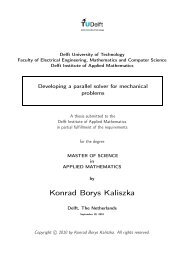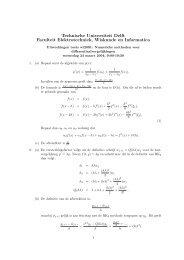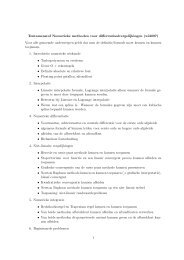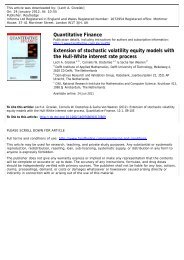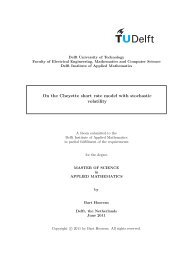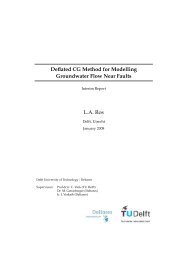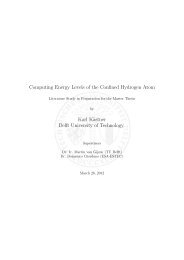90 C. W. OOSTERLEE <strong>AN</strong>D T. W<strong>AS</strong>HIOThe algorithms are described in a C-type metalanguage. The software is implementedas a combination of Fortran 77 and C. C is used for the driver routines ofthe preconditioner in order to exploit the recursiveness of C and so to simplify themultigrid implementation.Storage. The parameter m represents the number of vectors stored after whichthe GMRES(m) algorithm will restart. It is set to 20 in our work. Restart vectorsare not necessary in BiCGSTAB, where six intermediate vectors have to be stored.The work for one GMRES iteration consists of one matrix–vector product and onepreconditioning step. In BiCGSTAB two matrix–vector products and two preconditioningsteps are necessary in each iteration. The computation of one iteration ofBiCGSTAB is twice as expensive as an iteration of GMRES(m), when, as in our case,the computation is dominated by the preconditioning and the matrix–vector product.When the number of iterations needed for convergence is much larger than the restartparameter m, it might be better to choose BiCGSTAB.Parallelism is straightforward in Krylov methods, except for the multigrid preconditioner,the matrix–vector, and inner products, which need communication amongneighboring processors.Using a preconditioner as solver. A preconditioner, like the multigrid preconditioner,can easily be used as a solver. An iteration of a multigrid solver is equivalentto a Richardson iteration on the preconditioned matrix. With K being the iterationmatrix, multigrid can be written as follows:(4)Kφ (k+1) + (A − K)φ (k) = b.This formulation is equivalent to(5)φ (k+1) = φ (k) + K −1 (b − Aφ (k) ) = φ (k) + K −1 r (k) ; r (k+1) = (I − AK −1 )r (k) .The multigrid solver is implemented as a Richardson iteration with a left multigridpreconditioner for A. The convergence of (5) can be investigated by analyzing thespectrum of the iteration matrix. The spectral radius of I −AK −1 determines the convergence.This spectrum is analyzed in section 3 for the different multigrid methodsfor the problems tested on 33 2 and 65 2 grids. With this spectrum we can also investigatethe convergence of GMRES, since the spectra of left and right preconditionedmatrices are the same.Nested iteration ([6]), or full multigrid (FMG), which often reduces the numberof multigrid iterations, is closely related to the multigrid algorithms considered here.Our starting point is the sparse matrix on the finest grid, but an F-cycle withoutpresmoothing is always used.The convergence of GMRES. Here, we give an estimation of the convergence ofGMRES(m) in cases where most of the eigenvalues (the last n − l eigenvalues in thetheorem below) of the preconditioned matrix à are close to 1 ∈ C.THEOREM 2.1. Let à be an n × n nonsingular matrix with eigenvalues {λ i ∈C | 1 ≤ i ≤ n}, and let ¯V l be the subspace spanned by the vectors {v ∈ V | ∏ nk>l (λ kI −Ã)v = 0}, let K l be the Krylov subspace K(l, r (0) , Ã) = span[r(0) , Ãr(0) , . . . , Ãl−1 r (0) ],and let P k be a set of kth-order complex polynomials p k (λ) that satisfy p k (0) = 1, andr (0) = b − Ãφ(0) the initial residual. Let radius Γ i be defined as(6)Γ i := max{||(λ i I − Ã)v|| 2 |v ∈ ¯V i−1 ∩ K i ; ‖v‖ 2 = 1}.
Then a vector ¯r (l) defined by(7)<strong>MULTIGRID</strong> <strong>AS</strong> A <strong>SOLVER</strong> <strong>AN</strong>D A PRECONDITIONER 91¯r (l) :=( l∏i=1)1(λ i I −λ Ã) r (0)iis included in ¯V l ∩ K l+1 .Furthermore,(8)( l∏)‖¯r (l) Γ i‖ 2 ≤‖r (0) ‖ 2 .|λi=1 i |Assuming l < k ≤ m, then the norm of the residual of kth GMRES(m) iteration canbe estimated as follows:(9)(10)‖r (k) ‖ 2 ≤ min{‖p k−l (Ã)¯r(l) ‖ 2 | p k−l (λ) ∈ P k−l }≤ ‖(I − Ã)k−l¯r (l) ‖ 2 .Proof. Inequality (8) is found by induction: ¯r (l) = 1 λ l(λ l¯r (l−1) − ïr(l−1) ) ∈¯V l ∩ K l+1 , so∥ ‖¯r (l) ‖ 2 =1∥∥∥2∥ (λ l I −λ Ã)¯r(l−1) ≤ Γ l(11)l |λ l | ‖¯r(l−1) ‖ 2 .GMRES(m) is one of the algorithms which searches an update q in the Krylov subspaceK(k, r (0) , Ã) since it minimizes residual r(k) = b − Ã(φ(0) + q) = r (0) − Ãq atthe kth iteration ([14]). Hence, from this fact,(12)‖r (k) ‖ 2 = min{‖p k (Ã)¯r(0) ‖ 2 | p k (λ) ∈ P k }is satisfied for k ≤ m. From (12) and the fact that( l∏)λ i − λ(13)s k (λ) =p k−l (λ)λi=1 iis included in P k for an arbitrary p k−l (λ) ∈ P k−l , inequality (9) is obvious.Inequality (10) is found with (1 − λ) k−l as a choice for p k−l (λ) in (9).Although à is not symmetric in our case, it might be helpful for understanding(8) to consider the symmetric case. As upperbound for Γ i it then follows that(14)Γ i ≤ ¯Γ i =: max{||(λ i I − Ã)v|| 2 |v ∈ ¯V i−1 ; ‖v‖ 2 = 1}= max{|λ i − λ j | | j ≥ i}.Figure 2 shows ¯Γ i in this case.When à is nonsymmetric, we see that(15)¯Γ i ≥ max{|λ i − λ j | | j ≥ i}.Here are some remarks concerning the theorem.Remark 2.1.1. If some eigenvalues λ i (i ≤ l) are close to zero, the norm of ¯r (l)becomes large. This suggests that we may need a relatively large k to reduce theresidual by a certain order of magnitude even if l is not large.




